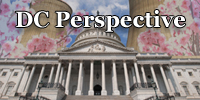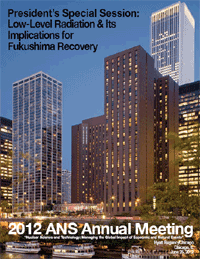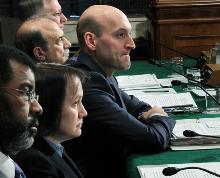Japan’s Non-nuclear decision
Implementation of the energy policy announced last week will keep reactors running well into the second half of the 21st century.

Implementation of the energy policy announced last week will keep reactors running well into the second half of the 21st century.
 Both the Republicans and the Democrats have recently released their party platforms. Here's a look at what each platform has to say about energy and environmental issues in general, and on nuclear specifically.
Both the Republicans and the Democrats have recently released their party platforms. Here's a look at what each platform has to say about energy and environmental issues in general, and on nuclear specifically.
At the ANS 2012 Annual Meeting, ANS Public Information Committee's Dan Yurman caught up with Dr. Wade Allison, of Oxford University, UK. They discussed radiation, health effects, Fukushima, Dr. Allison's recent book Radiation and Reason, and Dr. Allison's recent trip to Japan in this video interview.
On Friday, March 11, 2011, one of the largest earthquakes in the recorded history of the world occurred on the east coast of northern Japan. The earthquake generated a major tsunami, causing nearly 20,000 deaths.
 The American Nuclear Society's annual meeting for 2012 included a President's Special Session titled Low-Level Radiation & Its Implications for Fukushima Recovery (Warning-the link leads to a 54 MB, 208 page PDF full of disruptive information that might change your opinion on the benefits of spending billions of dollars every year to keep radiation doses as low as unreasonably achievable).
The American Nuclear Society's annual meeting for 2012 included a President's Special Session titled Low-Level Radiation & Its Implications for Fukushima Recovery (Warning-the link leads to a 54 MB, 208 page PDF full of disruptive information that might change your opinion on the benefits of spending billions of dollars every year to keep radiation doses as low as unreasonably achievable).
Facts vs. myths about the health effects of Fukushima and Chernobyl. The conclusions of scientists studying health consequences may be startling to those exposed only to commonly held beliefs and traditional media (and Chernobyl Diaries!)
The University of California-Berkeley Nuclear Engineering Department has been awarded an American Nuclear Society Presidential Citation, ANS President Eric Loewen announced today. Loewen will present the award to UC-Berkeley nuclear engineering department representatives during the President's Session of the ANS Annual Conference, Nuclear Science and Technology: Managing the Global Impact of Economic and Natural Events, being held June 24-28 in Chicago, Ill.
In recent days, a number of articles have been printed that assert that a grave danger exists at the Fukushima Daiichi nuclear generating station. These articles claim that this danger exists due to the condition of the spent nuclear fuel at the site and the supposedly shaky condition of its storage and care. Two examples:
This evening there will be a debate on a nuclear referendum that is on the town ballot in Plymouth, Mass. The referendum calls for a halt to relicensing the Pilgrim nuclear power plant, pending implementation of Fukushima lessons learned.
American Nuclear Society Vice President/President Elect Michael Corradini-co-chair of the ANS Special Committee on Fukushima-discusses the findings of the ANS Special Committee report and other Fukushima-related matters in this news clip, filmed in conjunction with a March speaking engagement at an Oak Ridge/Knoxville ANS Local Section dinner meeting.
 After giving a brief update on recent Fukushima-related events in the United States, I'd like to talk about some good (but relatively unpublicized) things that have happened during what has otherwise been a very challenging year for the nuclear industry. Then I'll discuss what, to me, was the most disconcerting story in the past year.
After giving a brief update on recent Fukushima-related events in the United States, I'd like to talk about some good (but relatively unpublicized) things that have happened during what has otherwise been a very challenging year for the nuclear industry. Then I'll discuss what, to me, was the most disconcerting story in the past year.
Japan's new political leadership represents a sea change in the post-Fukushima era

NRC Commissioners Magwood, Svinicki, Chairman Jaczko, Apostolakis, Ostendorff
A hearing titled "Lessons from Fukushima One Year Later: NRC's Implementation of Recommendations for Enhancing Nuclear Reactor Safety in the 21st Century" will be held in the U.S. Senate this morning at 10:00 AM EDT. Witnesses will include NRC chairman Gregory Jaczko and fellow NRC commissioners Kristine Svinicki, George Apostolakis, William Magwood, and William Ostendorff.
A hearing titled "Lessons from Fukushima One Year Later: NRC's Implementation of Recommendations for Enhancing Nuclear Reactor Safety in the 21st Century" will be held in the U.S. Senate on Thursday, March 15, at 10:00 AM EDT. The hearing will be a joint session of the Senate's Committee on Environment and Public Works and the Subcommittee on Clean Air and Nuclear Safety.
The American Nuclear Society Special Committee on Fukushima will issue its full report on March 8 at the National Press Club in Washington, DC, at 10AM EST. The press conference will be available for viewing via this link.
We are within one week of the one year anniversary of the Great North East Japan Earthquake and Tsunami. That powerful punch from nature slowly destroyed four out of six of the nuclear units at Fukushima Daiichi while the world watched with rapt attention.
Retrospective and prospective views
The American Nuclear Society Special Committee on Fukushima has been conducting a comprehensive study of the events at the Fukushima Daiichi nuclear power plant following the Great East Japan earthquake of 2011. The special committee was tasked with providing a clear and concise explanation of what happened during the Fukushima Daiichi accident, and offer recommendations based on lessons learned. A report from the special committee will be released at a press conference on Thursday, March 8, at 10AM EST. The press conference will be webcast at http://www.visualwebcaster.com/event.asp?id=85244, and the report will be available for download at http://fukushima.ans.org/.
Since the Fukushima accident last March, several Japanese investigative groups have been created to try to establish what actually happened. As the number of groups has grown, some confusion has understandably emerged. Here's a "scorecard" of the five primary Japanese investigative commissions, with a brief description of each.
Webcast event available from National Press Club